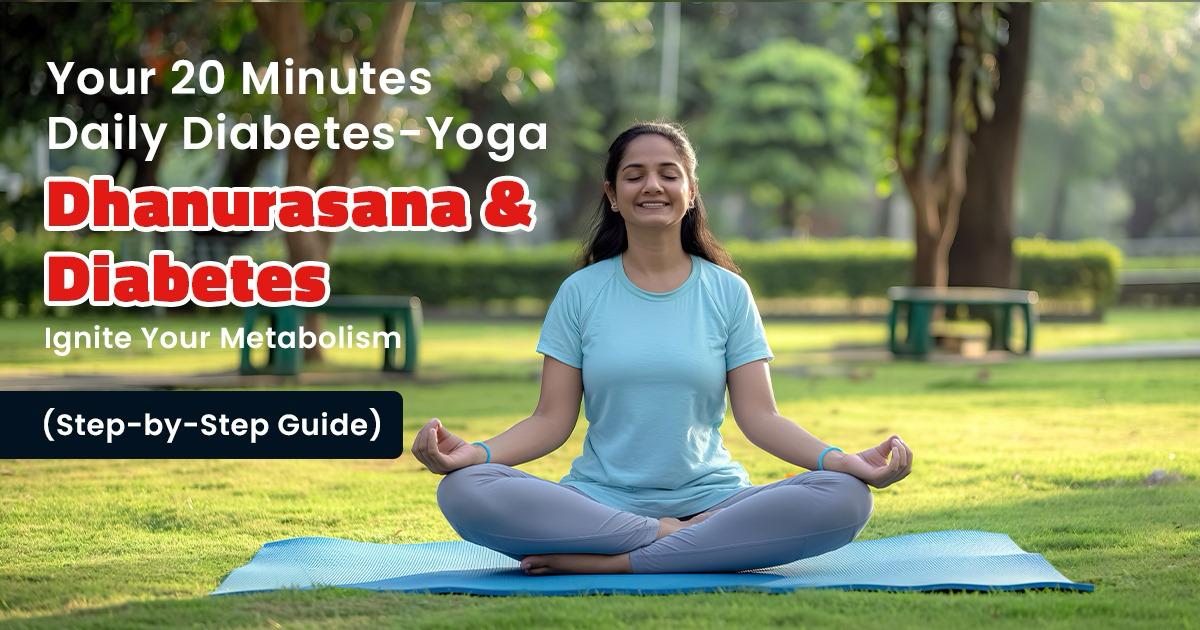Your 20‑Minute Daily Diabetes‑Yoga Flow
Subtitle: Dhanurasana & Diabetes – Ignite Your Metabolism (Step-by-Step Guide)
Sre Iswarrya Hospital
July 09, 2025

If someone told you that you could support your blood sugar levels, feel more relaxed, and improve your metabolism in just 20 minutes a day—without any medication—wouldn’t you be curious? That’s the power of yoga for diabetes.
In this blog, we’ll show you how to create a quick yet powerful daily routine using yoga. We’ll also give you a detailed breakdown of Dhanurasana (Bow Pose), one of the most effective postures to stimulate the pancreas and support blood sugar balance. We’ll explore how yoga helps with insulin resistance, guide you through each movement, and answer common questions to help you get started safely.
How Yoga Helps with Diabetes
- Reduces stress: Chronic stress raises cortisol, which increases blood sugar. Yoga activates the parasympathetic nervous system (rest-and-digest response).
- Improves insulin sensitivity: Studies show that yoga lowers fasting blood glucose and HbA1c.
- Enhances circulation: Helps improve oxygen and nutrient delivery, especially to extremities (hands, feet).
- Strengthens digestive organs: Twists and abdominal poses stimulate the pancreas and liver.
Research from the Journal of Diabetes Research shows significant improvements in insulin sensitivity and stress biomarkers in patients practicing yoga 4–5 times a week.
20-Minute Daily Yoga Routine for Diabetes
This routine includes 5 stages: Warm-up, Activation, Core Flow (featuring Dhanurasana), Cool Down, and Relaxation.
Total Duration: 20 Minutes
| Stage |
Time |
Postures |
| Warm-Up | 3 min | Seated breathing, neck and shoulder rolls |
| Activation | 5 min | Tadasana, Ardha Matsyendrasana, Bhujangasana |
| Core Flow | 7 min | Dhanurasana (main pose), Child’s Pose |
| Cool Down | 3 min | Paschimottanasana, Viparita Karani |
| Relaxation | 2 min | Savasana |
Step-by-Step Breakdown of Each Pose
- Seated Breathing (Anulom Vilom)
Sit cross-legged. Close your right nostril with your thumb. Inhale through the left, then switch. Exhale through the right. Repeat for 1–2 minutes.
- Tadasana (Mountain Pose)
Stand tall, feet hip-width. Inhale and raise your arms overhead. Exhale and release slowly. Repeat for 5 breaths.
- Ardha Matsyendrasana (Half Spinal Twist)
Sit with legs extended. Bend the right leg, place the foot outside the left knee. Twist gently to the right. Hold for 5 breaths. Repeat on the other side.
- Bhujangasana (Cobra Pose)
Lie on your stomach, hands under shoulders. Inhale and lift chest while keeping elbows soft. Hold for 15–30 seconds. Exhale and release.
- Dhanurasana (Bow Pose)
Lie flat on your belly. Bend your knees and grab your ankles. Inhale, lift your chest and thighs. Hold the pose for 20–30 seconds. Exhale and release. Repeat 2–3 rounds.
Why it works: Dhanurasana massages the pancreas and improves digestion, making it ideal for people managing blood sugar.
- Paschimottanasana (Forward Fold)
Sit with legs straight. Inhale, lengthen spine; exhale, fold forward. Hold for 30 seconds to 1 minute.
- Viparita Karani (Legs Up the Wall)
Lie on your back with legs resting vertically on the wall. Hold for 1–2 minutes.
- Savasana (Corpse Pose)
Lie flat on your back. Let go of tension from head to toe. Breathe naturally for 2–3 minutes.
Sample Weekly Schedule
| Day | Focus Area |
|---|
| Monday | Stress relief and full flow |
| Tuesday | Core strength (add more Dhanurasana) |
| Wednesday | Flexibility (longer hold in forward folds) |
| Thursday | Restorative focus (Viparita Karani) |
| Friday | Activation + Detox (add twists) |
| Saturday | Full flow repeat |
| Sunday | Rest or light breathing only |
FAQs
- Q1. Can yoga alone reverse diabetes?
No. Yoga supports your overall care plan. Diet, exercise, and medications are still essential.
- Q2. Can I do yoga after meals?
Wait at least 2 hours after a heavy meal before practicing.
- Q3. Is Dhanurasana safe for everyone?
Avoid if you have back pain, ulcers, or hernias. Modify under guidance.
- Q4. Do I need props?
No, but a mat, wall space, and cushion can help beginners.
- Q5. How long before I see results?
Consistent practice 4–5 times a week may show effects in 4–6 weeks.
Cautions and Modifications
- Always warm up before deep bends.
- Skip Dhanurasana if you have spine or shoulder injuries.
- Never hold your breath during poses.
- Use support like folded blankets under hips for forward folds if tight.
Final Thoughts
Yoga isn’t a one-day fix, but with consistent practice, it can offer lasting results. A 20-minute daily flow designed for diabetes not only keeps your joints flexible but also helps you build a stronger metabolic system. Dhanurasana, when practiced correctly and regularly, adds a powerful digestive and hormonal boost.
It’s low-cost, accessible, and more effective than many people expect. No fancy equipment. No side effects. Just your breath, your body, and 20 focused minutes.
Whether you’re new to yoga or looking to deepen your routine, this simple flow can become a pillar in your diabetes care journey.
